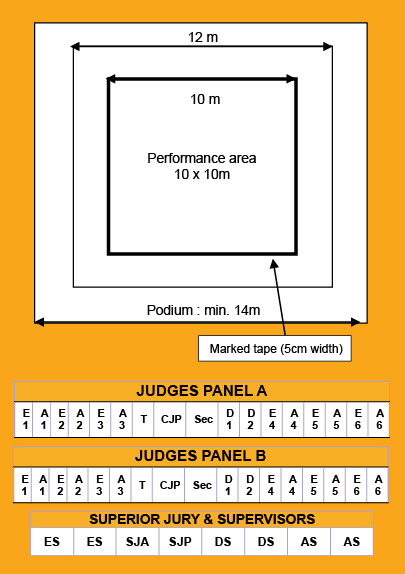
- PODIUM (See T.R.)
- COMPETITION FLOOR AND COMPETITION AREA (See T.R.)
The tape width (5cm) is included within the measurements of the competition area. (See Apparatus norms).
Only floors with a current valid FIG Certificate can be used at competitions.
- SEATING
The Judges Panels are seated directly in front of the Podium. (see T.R. for the distance)
The Line Judges are seated diagonally at two corners. (see Chapter 7; Line Judge)
The Superior Juries are seated on a podium immediately behind the Judges Panels.
Keys:
Line (L) – Artistry (A) – Execution (E) – Difficulty (D) –Time (T) – Chair (CJP) – LOC Secretary (Sec) – Execution Supervisor (ES) – Artistry Supervisor (AS) –Difficulty Supervisor (DS) – Superior Jury Assistant (SJA) – Superior Jury President (SJP)
- RESTRICTIONS
Coaches must remain in the Waiting Area with proper behaviors while their competitors are competing. Coaches, competitors, and all unauthorized persons are restricted from entering the judging area. Disregard of these restrictions may lead to the disqualification of the competitor by the Superior Jury.
During the performance of the routines, the coach of the Gymnasts (or any other member of the delegation) may not communicate with the gymnasts or the judges in any manner (see Undisciplined behavior in CJP).
1.13 MUSIC LENGTH
The length of the routine music is as follows with a tolerance of plus or minus 5 seconds (with increments of 1-second). The time begins with the first audible sound of the music (cue sign / beep sound is not included) and ends when the sound is not audible. (for Junior and Youth, see Part 5, Appendices)
- All categories: 1 minute 25 seconds ( ± 5 seconds)
1.14 MUSICAL ACCOMPANIMENT
- EQUIPMENT
- RECORDING
However, refer to the Directives and the Work Plan of the competition and follow the instructions of Organizing Committee for the format of the music file (ex: mp3)
Music from one routine only should be on the file format which the LOC requests. Competitors must bring two copies of their music to the competition and the music file should be named as follows:
- The name of the nation (official abbreviation of the country).
- The first and last name of the individual competitor and the last names of MP, TR, GR AD, AS.
- The category (IM, IW, MP, TR, GR, AD, AS) (Senior, Junior, Youth).
Delegation members are requested to have a spare copy of USB-stick of their music for their training sessions and in case of technical problems.
- QUALITY
- MUSIC RIGHTS
Together with the nominative entry, a list of all the music, title, artist, and composer used must be sent to the LOC and for the World Championships to the FIG Secretariat.
1.15 RESULTS
- DISPLAY AND DISTRIBUTION OF RESULTS
- INQUIRIES
- FINAL RESULTS
The score obtained in the Final determines the classification.
1.16 AWARDS
(see T.R. Section 1)
The responsible FIG official must approve the detailed organization.
A certificate of participation is given to all competitors and officials.
- CEREMONIES
The responsible FIG official must approve the detailed organization.
- AWARDS
A certificate of participation is given to all competitors and officials.
1.17 “AEROBIC GYMNASTICS”
- DEFINITION
- ROUTINE COMPOSITION CONTENTS
- Aerobic Movement Patterns
- Difficulty / Acrobatic Elements
- Transitions / Links
- Collaboration / Partnership (MP / TR / GR / AD / AS)
1.18 NEW DIFFICULTY ELEMENTS
The FIG AER TC who will evaluate them once per year can ONLY make classification of New Difficulty Elements. Applications must be sent to the FIG Secretariat before 15th of January.
Difficulty elements submitted for evaluation must:
If the above requirements are not met, the FIG AER TC will refuse to classify the difficulty elements.
Notification of the classification will be given to the applying member federation after the FIG AER TC makes the decision.
The FIG AER TC will publish the New Elements in the Newsletters once per year only.
Difficulty elements submitted for evaluation must:
- Not be a variation of an existing element except for the turns/twists increase (maximum of 3 revolutions) in Group B.
- Have written name of the element and description.
- Be filmed from two camera angles (from the front and the side)
- Meet the technical requirement of “recognition as valid element”.
- Be performed on a competition surface or a landing mat no higher than 15 cm.
If the above requirements are not met, the FIG AER TC will refuse to classify the difficulty elements.
Notification of the classification will be given to the applying member federation after the FIG AER TC makes the decision.
The FIG AER TC will publish the New Elements in the Newsletters once per year only.







